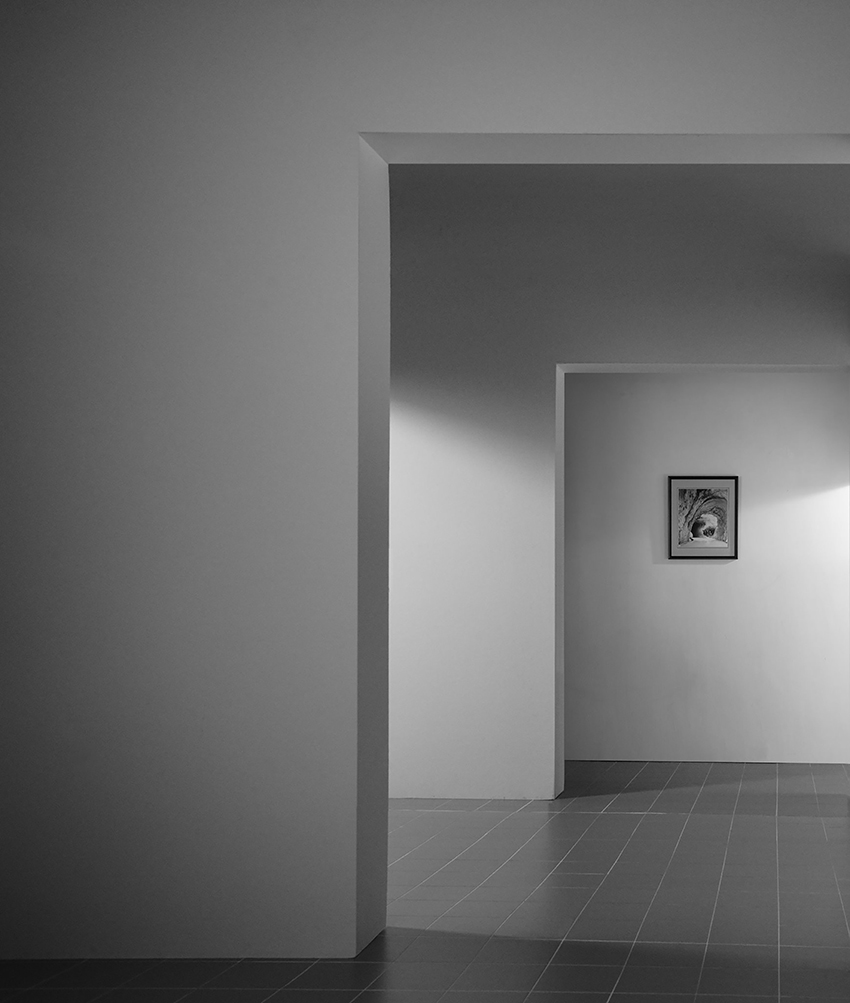

/
臨郎靜山洞中猛虎臥 微噴輸出於半光面相紙 ,120 x 101 公分,2016
Imitating Long Chinsan’s Tiger in Cave ,Giclée prints on semigloss photo paper, 120x101cm 2016
我選的這一張跟其他大家比較熟悉的郎靜山山水畫意的攝影有所不同,太有趣了,我看到這一張作品時哈哈大笑,有他作品中少見的幽默感。而他使用了老虎,讓我想到這背後有他想要指涉的精神內涵,例如以前的人學拳有虎形。在我自己的創作裡,也常常使用影像的空間作為某種內心風景的映照,所以我這次創造了一個比較像是白色的室內空間,但透過了空間的層疊方式也跟〈洞中猛虎臥〉這一件作品的空間結構有一個呼應。它有一個蠻清楚的透視點,我把原作擺在透視點的地方,就好像是這一個空間來到那張圖之後,又透過那張圖進到這一件作品的空間裡面。在這個設置上,我覺得我好像把他的這件作品當作是兩種空間,或是兩個時代的一個通道。當我這麼做的時候,我意識到我是在臨一幅畫,因為古人的臨跟摹仿不同,最重要的是臨他的精神。
The photograph I selected, unlike other more familiar landscape-oriented photographs by Lang Jingshan, is quite different and intriguing. When I saw this particular piece, I burst into laughter; it has a sense of humor rarely seen in his works. His use of a tiger made me think that there is a deeper spiritual meaning he wants to allude to, like the tiger form used in traditional martial arts.
In my own work, I often use the spatiality of imagery as a reflection of some inner landscapes. So this time, I created a space that resembles an indoor white space. However, through the layering of space, it also echoes the spatial structure of Lang Jingshan's work "Tiger in Cave." It has a clear vanishing point, and I placed the original work at that point, as if this space arrived at that image and then entered the space of this artwork through that image.
In this setup, I feel like I'm treating his work as two different spaces or a passage between two eras. When I did this, I realized I was copying a painting, but ancient Chinese painting differs from mere imitation; the most crucial aspect is to capture the spirit of the original work.
臨郎靜山洞中猛虎臥 微噴輸出於半光面相紙 ,120 x 101 公分,2016
Imitating Long Chinsan’s Tiger in Cave ,Giclée prints on semigloss photo paper, 120x101cm 2016
我選的這一張跟其他大家比較熟悉的郎靜山山水畫意的攝影有所不同,太有趣了,我看到這一張作品時哈哈大笑,有他作品中少見的幽默感。而他使用了老虎,讓我想到這背後有他想要指涉的精神內涵,例如以前的人學拳有虎形。在我自己的創作裡,也常常使用影像的空間作為某種內心風景的映照,所以我這次創造了一個比較像是白色的室內空間,但透過了空間的層疊方式也跟〈洞中猛虎臥〉這一件作品的空間結構有一個呼應。它有一個蠻清楚的透視點,我把原作擺在透視點的地方,就好像是這一個空間來到那張圖之後,又透過那張圖進到這一件作品的空間裡面。在這個設置上,我覺得我好像把他的這件作品當作是兩種空間,或是兩個時代的一個通道。當我這麼做的時候,我意識到我是在臨一幅畫,因為古人的臨跟摹仿不同,最重要的是臨他的精神。
The photograph I selected, unlike other more familiar landscape-oriented photographs by Lang Jingshan, is quite different and intriguing. When I saw this particular piece, I burst into laughter; it has a sense of humor rarely seen in his works. His use of a tiger made me think that there is a deeper spiritual meaning he wants to allude to, like the tiger form used in traditional martial arts.
In my own work, I often use the spatiality of imagery as a reflection of some inner landscapes. So this time, I created a space that resembles an indoor white space. However, through the layering of space, it also echoes the spatial structure of Lang Jingshan's work "Tiger in Cave." It has a clear vanishing point, and I placed the original work at that point, as if this space arrived at that image and then entered the space of this artwork through that image.
In this setup, I feel like I'm treating his work as two different spaces or a passage between two eras. When I did this, I realized I was copying a painting, but ancient Chinese painting differs from mere imitation; the most crucial aspect is to capture the spirit of the original work.